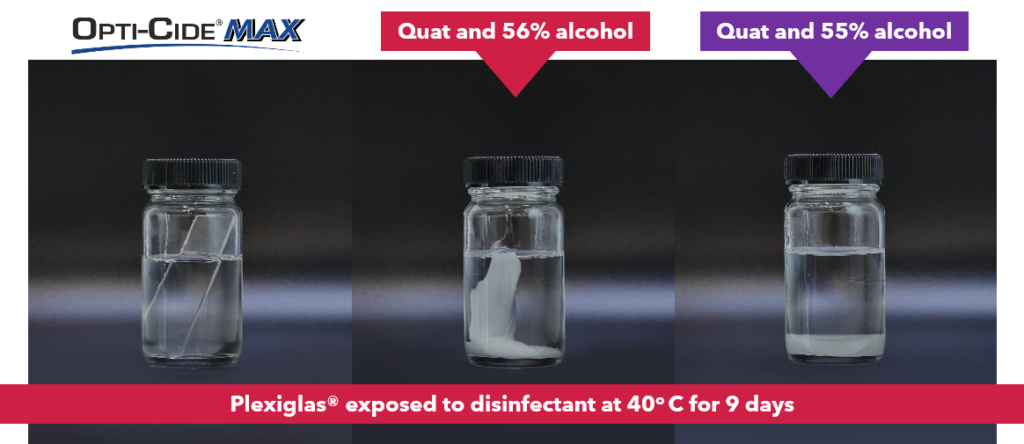Surface Compatability
Opti-Cide MAX is safe on clinical surfaces such as acrylic, aluminum, brass, copper, stainless steel, chrome, plastics and more. It cleans better than high alcohol formulas (55%) as it won't affix blood and soil to surfaces. Our low alcohol formula (20%) won't cloud plastics like high alcohol formulas. Opti-Cide MAX has a powerful scrubbing ability to quickly and effectively clean surfaces, while still being safe on surfaces. Opti-Cide MAX is a true broad spectrum disinfectant this is Bactericidal, Fungicidal, Virucidal, and Tuberculocidal.
SURFACE COMPATIBILITY COMPARISON
While other bleach-based and high alcohol disinfectants can damage surfaces, Opti-Cide MAX is broadly compatible with common surfaces used in healthcare facilities.


THE IMPORTANCE OF SURFACE COMPATIBILITY
Surface compatibility is much more important than one might realize. It is not just that a disinfectant may make something look old or unkempt. If the disinfectant starts to corrode a surface like a stainless steel counter, handrail, IV pole, medical device or instrument, initially the damage is often not visible. However, any damage invites bacteria to enter even the slightly pitted or damaged areas, find shelter, and initiate biofilm formation1. For example, this type of damage can occur when using strong acids, ammonia, or hypochlorite-based disinfectants (bleach) on items composed of stainless steel. The corrosive damage increases with repeated use of an inappropriate disinfectant expanding the area affected and the depth of the corrosion providing more shelters to serve as pathogen reservoirs.
There are additional concerns. If the stainless steel item is thin, corrosion will weaken the metal. If it has a sharp blade, the edge will be dulled and microscopically jagged. Not only will the instrument function sub-optimally, but the chemical reactions on the now oxygen-exposed subsurfaces with mounting rust particles could injure the patient.
LCD touch screens can easily be ruined by incompatible chemicals. It is best to check with the manufacturer as mistakes can be costly. It is important when using a compatible cleaner or disinfectant on any monitor or television screen that you do not spray directly on to the screen as the droplets could penetrate poor seals and short the circuitry, or drip down and seep into the space between the screen and the protective cover.
1Source: Vickery K, Deva A, Jacombs A, et al. Presence of biofilm containing viable multiresistant organisms despite terminal cleaning on clinical surfaces in an intensive care unit. J Hosp Infect 2012;80:52- 55.
